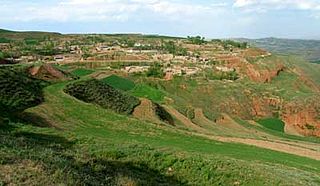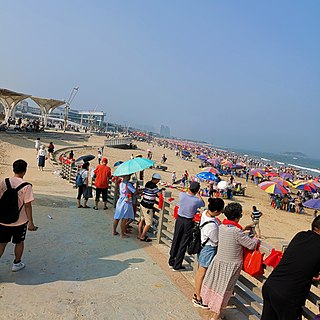Villages, formally village-level divisions in China, serve as a fundamental organizational unit for its rural population. Basic local divisions like neighborhoods and communities are not informal, but have defined boundaries and designated heads. In 2000, China's densely populated villages had a population greater than 500 million and covered more than 2 million square kilometers, or more than 20% of China's total area. By 2020, all incorporated villages had road access, the last village to be connected being a remote village in Sichuan province's Butuo County.

Xainza County, also Shantsa, Shentsa, is a county within Nagqu of the Tibet Autonomous Region of China. In 1999 the county had a population of 16,190.

Zhicheng is a town in Yidu County-level city, Yichang Prefecture-level city, Hubei Province, China. It is situated on the right (southern) shore of the Yangtze River, some 15 km southeast from downtown Yidu.

Taktser or Tengtser or Hongya Village is a village in Shihuiyao Township, Ping'an District, Haidong, in the east of Qinghai province, China,. Tibetan, Han and Hui Chinese people populate the village which is notable as the birthplace of the 14th Dalai Lama, Tenzin Gyatso.

Jiaqiong or Jakhyung Town, also known as Jongnag is a small town and township-level division in Baingoin County, Nagqu in the Tibet Autonomous Region of the People's Republic of China. It covers an area of 2,993 square kilometres (1,156 sq mi) and as of 2010 it had a population of 2926 people. Jiaqiong lies to the northwest of Beila, to the east of Amdo County, and south of Shuanghu County.

Zharen, also Zaring or Zharencun is a small town and township-level division of Amdo County in the Nagqu Prefecture of the Tibet Autonomous Region, in China. It is located at the side of the G109 road, 41.9 kilometres (26.0 mi) south of Amdo Town on the road from Nagchu Town, and approximately 20 kilometres (12 mi) east of the southern tip of Cona Lake. It has a population of 7875, living in 1479 households.

Tancheng (潭城镇) is the seat of Pingtan County, in Fuzhou, Fujian, China (PRC) seating its executive, legislature, judiciary, CPC and PSB branches. It is located on Haitan Island.

Sandouping is a town in Yiling District of Yichang prefecture-level city in the Chinese province of Hubei. It is located on the right (southern) bank of the Yangtze River, next to Yiling District's border with Zigui County to the west. Sandouping is best known as the location of the Three Gorges Dam, which is the world's largest electricity-generating plant of any kind.
Baidi is a small village in Baidi Township, Nagarzê County, Lhoka (Shannan) Prefecture, Tibet Autonomous Region, China. It is located at the western end of Yamdrok Lake. Near the village the Yamdrok Hydropower Station, the largest power station in Tibet, was completed and dedicated in 1996.

Pana, or Pagnag, also known as Anduo, or Amdo, is a town and the seat of Amdo County in the Nagqu Prefecture of the Tibet Autonomous Region, in China. It lies 464 kilometres north of Lhasa and 138 km north of Nagqu. As of 2004 its jurisdiction had a population of about 2700, 683 of which were living in the town of Pana. The principal economic activity is animal husbandry, pastoral yak, goat, sheep, and so on. Blueschist outcrops are found in the area. The villagers in recent times organized a railway protecting committee to select locals to monitor the Qinghai-Tibet Railway.
"Constructed on the southern side of the Dangla Mountains, Amdo is a Chinese-style town on the Qinghai-Tibet Highway. The road here leads off to the west, heading towards the Mt. Kailash area via the Changthang Plateau. Many of the buses from Golmud to Lhasa used to stay overnight here."

Qiangma, also Qangma or Qiangmazhen is a small town and township-level division of Amdo County in the Nagqu Prefecture of the Tibet Autonomous Region, in China. It is located just south of Zi Getangcuo Lake, 90.7 kilometres (56.4 mi) southwest of Amdo Town. It covers an area of 5,467 square kilometres (2,111 sq mi) and as of 2004 it had a population of about 1700. The principal economic activity is animal husbandry, pastoral yak, goat, sheep, and so on.

Yanshiping is a small town physically situated in the southwest of Qinghai province, China. However, it is under the jurisdiction of Amdo County in the Nagqu Prefecture of the Tibet Autonomous Region. At an elevation of 4,720 metres (15,490 ft), it is one of the highest year-round settlements in the world.

Liuji is a town of Dawu County in northeastern Hubei province, China, located 33 kilometres (21 mi) southeast of the county seat.

Xinshi is a town in and the seat of Jingshan County in Jingmen, east-central Hubei province, China. The towns geographical coordinates are 31° 1' 19" North, 113° 6' 11".
Long or Nong is an unclassified Loloish language of Huaning County, Yunnan, China. It is also called Luowu 罗婺.
Adu is an unclassified Loloish language of Huaning County, Yunnan, China.

Wulipu is a town in the northwest corner of Shayang County, Jingmen, Hubei Province, China. The name 'Wulipu' means 'a relay station for post horses five Li away from the city'.

Wutuan is a rural town in Chengbu Miao Autonomous County, Hunan, China. As of the 2015 census it had a population of 13,476 and an area of 173-square-kilometre (67 sq mi). The town shares a border with Pingdeng Town to the west, Dingping Township to the east, Baimaoping Township to the north, and Weijiang Township to the south. It is a major border trade town, because its north and west sides are Guangxi Zhuang Autonomous Region.

Chenjiagang, often abbreviated to Chengang, is a town in Xiangshui County, Jiangsu, China.











